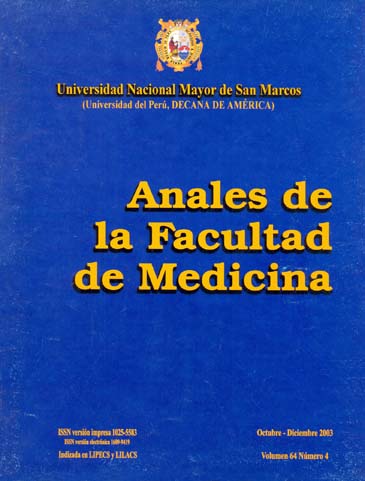The evolution of malaria at Loreto Region
DOI:
https://doi.org/10.15381/anales.v64i4.1432Keywords:
Malaria, malaria, vivax, falciparum, plasmodium vivax, PeruAbstract
Objectives: To describe the evolution of malaria at the Loreto Region, comparing vivax with falciparum malaria, its evolution in comparison with the rest of Peru and the changes in medicinal policy. Material and methods: Observational and descriptive study. The Ministry of Health General Epidemiology Office was the source of information. Results: Both vivax and falciparum malaria incidence at the Loreto Region has increased since 2000, following a reduction of 40%. An increase of 24% was reported in 2001 with respect to 2000 and 52% in 2002 with respect to 2001. As a percentage of all cases in Peru, Loreto accounted for 29%, 31%, 44%, 47% and 57%, respectively, in the years 1998 through 2002. Loreto has been at high risk since 1995. In 2003 at the 46rd Epidemiology Week (09th – 15th November) Loreto (IPA 45) and San Martin (IPA 10) were placed at high risk; 60,4% of all cases come from Loreto. Conclusions: Loreto Region malaria incidence has been increasing in the last 3 years. Peruvian cases of malaria in the last few years have been centered at the Loreto Region.Downloads
Published
2003-12-31
Issue
Section
Tema de Debate
License
Copyright (c) 2003 JUAN CELIS S, ROXANA MONTENEGRO, ALFREDO CASTILLO, ELIZABETH CHE, ANIBAL MUÑOZ

This work is licensed under a Creative Commons Attribution-NonCommercial-ShareAlike 4.0 International License.
Those authors who have publications with this magazine accept the following terms:
- Authors will retain their copyrights and guarantee the journal the right of first publication of their work, which will be simultaneously subject to Creative Commons Attribution License that allows third parties to share the work as long as its author and its first publication this magazine are indicated.
- Authors may adopt other non-exclusive licensing agreements for the distribution of the version of the published work (eg, deposit it in an institutional electronic file or publish it in a monographic volume) provided that the initial publication in this magazine is indicated.
- Authors are allowed and recommended to disseminate their work over the Internet (eg: in institutional telematic archives or on their website) before and during the submission process, which It can produce interesting exchanges and increase quotes from the published work. (See El efecto del acceso abierto ).
How to Cite
1.
Celis S. J, Montenegro R, Castillo A, Che E, Muñóz A. The evolution of malaria at Loreto Region. An Fac med [Internet]. 2003 Dec. 31 [cited 2024 Jul. 17];64(4):261-6. Available from: https://revistasinvestigacion.unmsm.edu.pe/index.php/anales/article/view/1432















